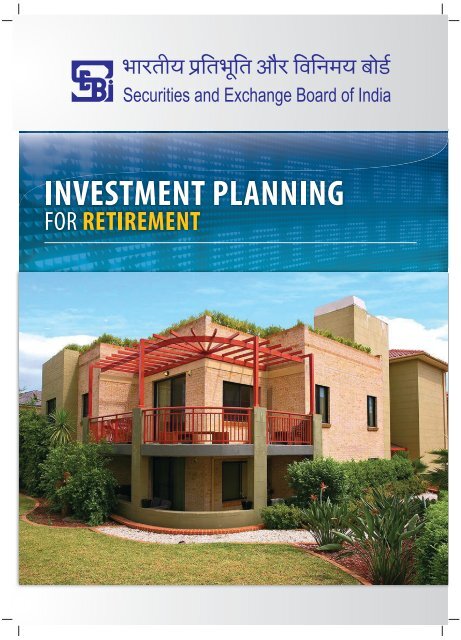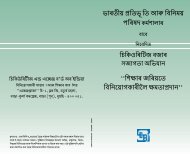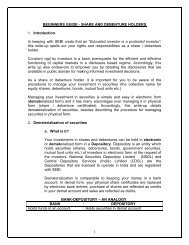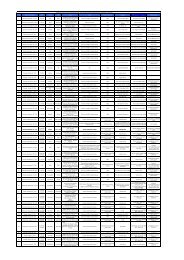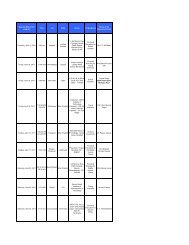Booklet - SEBI Investor Awareness Website
Booklet - SEBI Investor Awareness Website
Booklet - SEBI Investor Awareness Website
- No tags were found...
You also want an ePaper? Increase the reach of your titles
YUMPU automatically turns print PDFs into web optimized ePapers that Google loves.
Key Learning Objectives:<br />
After reading this booklet, you will be able to understand the<br />
following:<br />
• Need for an investment plan<br />
• Financial implications of your investment decision<br />
• Various investment avenues in the Indian financial market<br />
• Investment strategies to achieve your financial goals<br />
• Calculation of personal networth and annual personal budget<br />
TABLE OF<br />
CONTENTS<br />
1. INTRODUCTION<br />
2. RETIREMENT PLAN<br />
3. FINANCIAL PLANNING<br />
4. SMART GOALS<br />
5. SAVINGS AND INVESTMENT<br />
6. LOANS VS. INVESTMENT<br />
7. PERSONAL BUDGET CALCULATOR<br />
8. PERSONAL NETWORTH CALCULATOR<br />
9. RISK VS. RETURN<br />
10. COMPOUNDING<br />
11. INFLATION EFFECTS ON INVESTMENTS<br />
12. RETIREMENT PLANNING<br />
13. INVESTMENT COMMANDMENTS<br />
14. INVESTMENT VEHICLES<br />
15. AVOID INVESTMENT SCAMS<br />
16. ESTATE PLANNING<br />
17. SUMMARY<br />
18. REFERENCES<br />
19. TERRITORIAL JURISDICTION OF <strong>SEBI</strong> OFFICES<br />
3
1. INTRODUCTION<br />
You have successfully passed through the many phases of life, overcame many<br />
hurdles in your long career, seen its ups and downs. Now it’s the time to enter a new<br />
phase—Retirement. It means retiring from work, not life. Like changing from the fast lane to<br />
the slower lane where the drive is far more relaxed, scenic and full of pleasure. It’s just another<br />
phase in one’s life. However, don’t forget that retirement is a state of mind as well as a financial<br />
issue.<br />
For most people, the regular income comes in the form of a salary, which is paid monthly.<br />
Because of the regularity of income during our working life, we usually adapt our spending<br />
to fit in with our income patterns. By the time retirement comes around we usually have our<br />
income and spending patterns well practised, although these may change a little in retirement.<br />
During retirement, or at some stage before, we also need to plan what we are going to do with<br />
our retirement savings. Usually this will involve looking at what to do with our superannuation<br />
money and any other savings that we may have accumulated along the way. In view of the<br />
above facts, it falls on the concerned person to do financial planning in a way he/she not only<br />
maintains the lifestyle but also has financial independence as well.<br />
2. RETIREMENT PLAN<br />
There are many factors related to retirement planning and it is never too early to begin. You may<br />
define your retirement goals and need to start a retirement savings plan before considering<br />
actual retirement.<br />
Follow the following four simple steps to arrive at an ideal retirement plan.<br />
Step 1: Decide how much income you require to live comfortably in your post-retirement<br />
years. Remember to take into account aspects like increased medical costs, expenses and gifts<br />
for family.<br />
Step 2: Calculate the amount to be received in lump sum (terminal benefits) at the time of<br />
retirement.<br />
Step 3: Select the right retirement plan that enables you to meet your post-retirement<br />
requirements. Preferably, choose to invest in asset classes , which can provide you with<br />
potentially higher returns in the long run.<br />
Step 4: Start investing early so that you have time on your side and can enjoy the power of<br />
compounding.<br />
1. Decide<br />
your Income<br />
Requirement<br />
2. Calculate<br />
Lumpsum<br />
Receivable<br />
3. Select a<br />
Retirement Plan<br />
4. Start Early<br />
Take into account<br />
• Increased medical<br />
costs, expenses<br />
• Gifts for family<br />
You ought to<br />
calculate<br />
• Terminal benefits<br />
at the time of<br />
retirement<br />
Aiming at achieveing<br />
post-retirement<br />
requirements<br />
• Invest in asset<br />
classes providing<br />
potentially higher<br />
returns in the long<br />
run<br />
Advantage of having<br />
time on your side<br />
• Reap the benefits<br />
of compounding<br />
4
How much retirement income will I need<br />
An easy rule of thumb is that you’ll need to replace 70 to 90 percent of your pre-retirement<br />
income. If you’re earning ` 20,000 a month (before taxes), you might need ` 15,000 to ` 18000<br />
a month in retirement income to enjoy the same standard of living you had before retirement.<br />
The following example illustrates the amount needed as retirement corpus to ensure a steady<br />
flow of monthly income.<br />
Calculation of retirement corpus:<br />
Retirement Age 60<br />
Current Age 58<br />
Life expectancy 83<br />
Years after retirement 23<br />
Current Annual Expenses ` 1.80 lacs<br />
Average Return on investment 12%<br />
Inflation 5%<br />
Inflation adjusted return 7%<br />
Total retirement corpus required ` 15 lacs*<br />
Action Points: How to Prepare for Retirement<br />
1. It’s never too late to start. It’s only too late if you don’t start at all.<br />
2. Deposit everything you can into your retirement plans and personal savings.<br />
3. Reduce expenses and funnel the savings into your kitty.<br />
4. Aim for higher returns and tax savings. Don’t invest in anything you are not comfortable with.<br />
5. Refine your goals. You may have to live a less expensive lifestyle in retirement.<br />
6. Sell assets that are not producing income or growth and invest in income-producing assets.<br />
* While a corpus of ` 15 lacs may be adequate at the beginning of your retirement, it would not<br />
be enough in later part of your retired life due to inflation that would increase your expenses<br />
for the same goods and services.<br />
5
3. FINANCIAL PLANNING<br />
“The best time to plant a tree was yesterday. The second best time to plant a tree is today.“<br />
Financial planning is the process of meeting your financial goals through the proper<br />
management of your finances. Financial planning helps you make advance provision for<br />
financial needs that will arise in the future. The objective of financial planning is to ensure that<br />
the right amount of money is available at the right point in time in the future to achieve an<br />
individual’s goals.<br />
Investment Planning<br />
Financial and investment planning are terms that are interchangeably used in personal<br />
finance parlance. To understand the difference between the two concepts, we first have to<br />
understand them well. Investment Planning (IP) has the “rate of interest” factor at its core. The<br />
Investment Planning process involves several steps, ranging from setting investment goals<br />
and understanding the risk appetite to designing an investment portfolio after evaluating the<br />
markets and the investment landscape. Investment Planning refers to a commitment of funds<br />
to one or more assets that will be held over a specific period. Anything not consumed today<br />
and saved for future use can be considered an investment.<br />
Planning Process<br />
The five steps of the financial planning process are:<br />
• Gathering your financial data such as details on your income, debt level, commitments,<br />
etc.<br />
• Identifying your goals<br />
• Identifying any financial issues or gaps between where you are now financially and where<br />
you want to be<br />
• Preparing your financial plan, which will identify recommended investments and will<br />
address your attitude to risk<br />
• Implementing financial plan—review and revise your plan—to ensure it stays up-to-date<br />
and relevant to the economy and changing lifestyle<br />
Gather your<br />
financial data<br />
Identify your<br />
goals<br />
Identify<br />
financial gaps<br />
Prepare a<br />
financial plan<br />
Implement<br />
financial plan<br />
Details on your<br />
• Income<br />
• Debt level<br />
• Commitments<br />
Live your dream<br />
• Wedding of<br />
your daughter<br />
• World tour<br />
• Buying a car<br />
Analyse your<br />
financial<br />
strength<br />
• Where you are<br />
now<br />
• Where you<br />
want to be<br />
Identify<br />
recommended<br />
investments<br />
• Address your<br />
attitude to<br />
risk<br />
Review and<br />
revise your plan<br />
• Up-to-date<br />
• Relevant to<br />
economy and<br />
changing<br />
lifestyle<br />
FINANCIAL PLANNING PROCESS<br />
6
4. SMART GOALS<br />
A financial plan helps drive your financial decisions to a defined goal. It helps you determine how<br />
much to save today for the future you planned for, how much returns to expect on your savings and<br />
where to invest your savings to ensure that you get the returns you desire.<br />
Thus, planning your finances is a type of management that involves setting a mission and having<br />
a vision for your future. This is very crucial in the planning process as it allows you to design a path<br />
as to how you plan on achieving your objectives within a stipulated time frame.<br />
A critical first step in managing your finances is to be able to set up SMART financial objectives.<br />
Your goals have to be S (specific), M (measurable, motivated), A (Achievable), R (realistic, resourcebased),<br />
and T (time-bound, trackable). Many people make the mistake of stating general goals,<br />
which, more often than not, will not materialize.<br />
SPECIFIC<br />
MEASURABLE<br />
ACHIEVABLE<br />
REALISTIC<br />
TIME-BOUND<br />
SMART GOALS<br />
Incorrect Approach<br />
Right Approach<br />
Specific<br />
You need to know exactly what<br />
you want to achieve and when you<br />
want it.<br />
I need to set aside money<br />
for my grand daughter’s<br />
birthday next year.<br />
I need to set aside ` 10,000 for my<br />
grand daughter’s birthday next year.<br />
Measurable<br />
A goal should be measurable so<br />
that you know when you will<br />
achieve it.<br />
I will pay off most of my<br />
credit card debt soon.<br />
In the next six months, I will pay three<br />
of my two credit card bills in full.<br />
Achievable<br />
Your goal should be within<br />
reasonable reach.<br />
I will save money.<br />
I will save ` 48,000 each year by<br />
putting aside ` 4,000 a month.<br />
Realistic<br />
Your goals need to be based on<br />
resources and tasks that you can<br />
reasonably accomplish.<br />
By saving regularly, I will<br />
become a millionaire.<br />
By saving regularly, I will be debt free<br />
by next year and will have a savings<br />
kitty equal to six months of my living<br />
expenses by next December.<br />
Time-bound<br />
Goals with timelines allow you to<br />
track your progress and encourage<br />
you to keep going until you reach<br />
your goal.<br />
I will save money for my<br />
daughter’s marriage.<br />
I will save ` 50,000 a year for the<br />
next 10 years for my daughter’s<br />
marriage.<br />
7
Activity<br />
(The activity below is designed to help you in setting a financial mission and a vision.)<br />
Activity: read the questions carefully and answer them honestly.<br />
Your present: What is your current financial position Where do you stand today<br />
Your future: What is your financial plan for the future Say 10 years from now.<br />
Your reality: Do you have the skills to help you get there How do you plan to get there<br />
Planning for the future involves setting goals and objectives.<br />
For each goal, be sure to consider two very important aspects, your risk tolerance and the time<br />
frame within which you wish to achieve these objectives. Your personal level of risk tolerance<br />
will give you an idea in which securities you need to invest in and for how long in order to<br />
achieve the set objectives. The duration of a financial plan depends on the goals that it sets out<br />
to achieve. It can cover short-term, medium-term and long-term goals. Short-term goals are<br />
normally targeted in a one to three year framework; for example a vacation abroad, mediumterm<br />
goals fit into a three to five year horizon; for example, buying a vehicle and long-term<br />
goals are achieved in a period of five years or more; for example, buying a house, retirement<br />
planning.<br />
It is also important to consider your income per year and your level of savings. For example, you<br />
earn ` 180,000 a year and save 20% of it (` 36,000). You plan to send your child to Mumbai to<br />
complete his/her education and approximate a budget of ` 200,000. Your child is to complete<br />
his Higher Secondery Examination in four years. Thus, based on your risk tolerance you allocate<br />
money towards his education. If your risk tolerance is low, it may be difficult to fulfill your goal<br />
of sending your son to Mumbai to complete his education. But if you are someone who is not<br />
afraid to take risks, it is possible to make your dreams come true. Investing money in funds<br />
higher on the risk return scale is one possible solution. One should study the product well<br />
before investing to understand both risks and reward.<br />
Suppose you invest ` 36,000 in the first year, ` 25,000 in the second year, Rs30,000 each in the<br />
third and fourth year respectively, your total investment at the end of the four year is ` 121,000.<br />
8
This would mean investing in securities that yield an average of 22% rate of return, can only<br />
enable you to fulfill your goal of sending your child to Mumbai for his education.<br />
How did we arrive at this answer<br />
Using the future value formula, we can estimate the required rate of return (RROR), you do this<br />
on a trial and error basis, where ideally Left Hand Side = Right Hand Side.<br />
FV=∑[PV(1+r)n] = PV(1+r) 4 + PV(1+r) 3 + PV(1+r) 2 + PV(1+r) 1<br />
Where, FV= future value PV= present value R= rate of return N= number of years<br />
200,000=36000(1.22) 4 + 25000(1.22) 3 + 30000(1.22) 2 + 30000(1.22) 1<br />
200,000=79752.044 +45396.2+ 44652 + 36600<br />
200,000= 206,400.244<br />
Thus an investment of ` 121,000 in four years for an interest rate of approximately 22% will<br />
yield ` 206400.244. Being practical is the most crucial factor in financial planning; ask yourself<br />
whether you are able to tolerate such risk that will yield you return of 22%. Therefore, instead<br />
of putting your money at very risky product, it is advisable to select safer product or increase<br />
your saving amount or start saving early.<br />
Table 1: Typical long-term goals for Mr Prasanna Age: 50 Years<br />
Profession: Company Executive<br />
Goals Name Target Date from today Amount (` in lakh)<br />
Education-doctor Raja (son) 6 years 20.00<br />
Marriage Ramba (daughter) 10 years 35.00<br />
House Self 12 years 60.00<br />
Table 2: Typical short-term goals for Mr Prasanna Age: 50 Years<br />
Profession: Company Executive<br />
Goals Name Target Date from today Amount (`)<br />
Visit to Holy Place Self 6 months 20,000<br />
Purchase of a AC unit Self 2 months 28,000<br />
Activity<br />
Goals Your income P.Y. Your savings P.Y. Time frame Estimated<br />
Budget for<br />
achievement of<br />
goal<br />
Education<br />
Marriage<br />
Buy a house<br />
Buy a car<br />
Children’s education<br />
World tour<br />
Retirement<br />
Children’s marriage<br />
Risk tolerance<br />
Based on these aspects please construct a financial plan as to which investments you need to invest in and at what amount and<br />
duration in order to achieve your said targets.<br />
9
5. SAVINGS AND INVESTMENT<br />
Finding the Right Balance between Saving and Investing<br />
Saving and investing are two related, but independent, processes. Saving is the process of<br />
putting hard cash aside and parking it in extremely safe and liquid accounts such as Bank<br />
savings accounts. Investing is the process of using money (called capital) to buy an asset that<br />
you think will generate a safe and acceptable return over time, making you wealthier with<br />
each passing year. When you save, you’re preserving your money for a later time. When you<br />
invest, you’re taking some risk that you believe will make it possible for your investment to<br />
grow in value over time. While investing can help you achieve your long-term goals, saving is<br />
an effective way of managing your money to meet short-term needs and to provide a safety<br />
net for emergency expenses. When saving money, the primary emphasis is on the stability of<br />
the principal rather than return potential. On the other hand, investment means willing to take<br />
some risk and putting your money in instruments with potential of higher returns.<br />
6. LOANS vs. INVESTMENT<br />
There is a general confusion among people whether they should avail a loan or build<br />
investments to achieve their financial goal (for example, buying a house). There is no rule<br />
which says that either of the option is good, because it differs for each person’s capacity and<br />
the nature of debt or investment. The following points are worth remembering:<br />
• It purely depends on your financial strength and other factors.<br />
• Credit card debts and personal loans are very costly.<br />
• If you have a loan with a low interest rate and tax benefits as in the case of home loans, it is<br />
advantageous to go for a loan. If you have an investment plan where you can make good<br />
return, then you may opt for investment.<br />
• You have to be sure that the investment is not risky and will not affect your family if you lose<br />
the money. For example, if you are investing huge sums in share market from borrowed<br />
money that is very risky.<br />
7. PERSONAL BUDGET CALCULATOR<br />
Have a budget. Determine what you actually spend each month. There are fixed expenses<br />
like rent, loan repayments, etc. every month about which we can do little. The variable items<br />
such as food, clothing and entertainment are often, what takes money away from us. Use your<br />
discretion to contain these variable expenses to start saving.<br />
10
A Personal Budget is simple to prepare.<br />
Income. Add up your monthly income: salary and investment income.<br />
Expenses. Add up monthly expenses: rent, loan payments, average food bills, medical<br />
expenses, entertainment and so on. Determine an average for expenses that vary each month,<br />
such as clothing, or that don’t occur every month, such as car insurance. You will need to track<br />
how you spend cash for a month or two. Most of us are surprised to find out where and how<br />
much cash “disappears” each month.<br />
Subtract expenses from income. What if you have more expenses than you have income<br />
Not an uncommon problem. You have three choices: cut expenses, increase income, or both.<br />
Cut expenses. There are ways to reduce expenses, from reducing grocery consumption to<br />
shopping for low-cost items without compromising quality. Compare monthly variances<br />
between actual expenditure and budgeted expenditure<br />
Increase income. Improve your job skills or education to get a better paying job, or make<br />
money from a hobby. It is hard to apply a rule of thumb toward savings, because it varies with<br />
age and income level. Ten percent is a good start. If you find that is too high for you, don’t let<br />
that deter you. You can start by putting a little aside each month and then slowly increasing<br />
it.<br />
Activity<br />
Prepare a monthly budget by specifying your income in terms of all inflows of cash from<br />
whatever sources, after which you need to deduct all possible expenses you think will arise<br />
during the month. It is important to do this exercise before the start of the month so that you<br />
can anticipate what can be the likely level of investments. Rule of thumb ideally says that you<br />
need to save 20% of your income. Complete this exercise to see whether you really are!<br />
A: Income<br />
Salary<br />
Rent<br />
Interest per month<br />
Capital gains<br />
Business<br />
Other sources<br />
TOTAL INCOME<br />
B: Expenses<br />
Travel and transport<br />
Food and utilities<br />
Rent<br />
Leisure<br />
Insurance premium<br />
Children’s education<br />
Holidays<br />
Other<br />
TOTAL EXPENSES<br />
C: Savings = income − expenditure<br />
Your monthly budget<br />
11
To find out whether you are saving 20% of your income, you just need to multiply your savings<br />
by 100 and divide it by your total income. If the value is below 20, it means you are spending<br />
your money recklessly giving you an indication to start saving … it’s never too late!<br />
Typical Monthly Budget<br />
January<br />
Name: Krishnan, Age 59 Company Executive<br />
Income Amount (`) Expenses Amount (`)<br />
Salary 75,500 Committed (EMI) 32,500<br />
Investment Income 6,000 Living Expenses 28,700<br />
Pension<br />
Other expenses<br />
Others PF/LIC 10,500<br />
Income 81,500 Total Expenses 71,700<br />
Net Surplus 9,800<br />
8. PERSONAL NETWORTH CALCULATOR<br />
Your networth is simply the total value of what you own (assets) minus what you owe (liabilities).<br />
It’s a snapshot of your financial health. The first step in planning your finances is to know where<br />
you financially stand today, i.e., ascertaining your networth.<br />
Your Assets Your Liabilities Your Networth<br />
Include personal possessions,<br />
vehicles, home, savings<br />
account, and cash value of life<br />
insurance policies.<br />
Value of investments−shares,<br />
real estate, deposits, PF<br />
accounts.<br />
The remaining loan<br />
outstanding on your home,<br />
credit card debt, car loans,<br />
personal loans, income<br />
taxes dues, and any other<br />
outstanding bills.<br />
Calculate your networth periodically, say quarterly and keep track of changes. An increasing<br />
networth means you are financially doing well financially.<br />
Keep in mind the following points while calculating your networth<br />
1. Use current market value/realizable value.<br />
2. Estimate if you can’t be accurate.<br />
3. Be conservative.<br />
4. Avoid insignificant detail.<br />
12
Model Networth Statement<br />
Name: Raja Age: 58<br />
Professional in a company Networth as on 31 January<br />
Assets Rs (in lakhs) Liabilities ` (Lakhs)<br />
House 56.00 Home loan 17.50<br />
Savings a/s 00.32 Car loan 05.20<br />
Equities 03.50 Credit card 02.40<br />
Fixed Deposit 05.00 Personal loan 06.10<br />
Car 06.20 Total 31.20<br />
NSC 04.30<br />
Total 75.32 Networth 44.12<br />
9. RISK vs. RETURN<br />
Risk and investing go hand in hand. Risk can be defined as the chance one takes that all or part<br />
of the money put into an investment can be lost. The good news is that investing risk comes<br />
with the potential for investing reward – which is what makes the whole process worthwhile.<br />
The basic thing to remember about risk is that it increases as the potential return increases.<br />
Essentially the bigger the risk is, the bigger the potential payoff. (Don’t forget the two words -<br />
“potential payoff”. There are no guarantees)<br />
Even seemingly “no-risk” products such as savings accounts and government bonds carry the<br />
risk of earning less than the inflation rate. If the return is less than the rate of inflation, the<br />
investment has actually lost ground. This means your earnings aren’t being maximised as they<br />
could have been with a different investment vehicle.<br />
While you stay invested it is crucial that you take necessary measures to manage your risk.<br />
Once you invest in any asset class you should monitor your investments and keep yourself<br />
updated about various market happenings to avoid any pitfalls. Always check the potential<br />
risks when quoted returns are unusually high.<br />
Here’s an example of some of the asset allocation models for different stages in your investing<br />
life. What they show is a gradual movement from aggressive to conservative style of investment.<br />
Asset Mix<br />
Years to retirement Stocks Bonds Cash<br />
20 80% 10% 10%<br />
15 60% 30% 10%<br />
10 40% 50% 10%<br />
5 30% 60% 10%<br />
Remember that models such as these aren’t designed to predict a particular level of return.<br />
While allocating assets can help you moderate risk, it doesn’t eliminate the possibility of<br />
accumulating less than you’d like. Also, remember that an asset allocation isn’t fixed—as time<br />
passes and you near retirement, you may want to consider shifting some of your stock holdings<br />
into more conservative choices to avoid the impact of short-term drops in the market. It is<br />
better to understand the product well before investing.<br />
13
10. COMPOUNDING<br />
Time exerts the greatest influence on your investment portfolio than any other force.<br />
Through the power of compounding, a small amount of money over time can grow into a<br />
substantial sum. Compounding is an investor’s best friend. Investments can increase in value<br />
over time, and the longer the time frame, the greater the value. This is achieved through returns<br />
that are earned, but not spent. When the return is reinvested, you earn a return on the return<br />
and a return on that return and so on. Therefore, it is important to start saving early in order to<br />
benefit from the power of compounding returns.<br />
The time value of money is the value of money that has earned an interest over a given amount<br />
of time. For example: ` 100 invested today for one year at 5% interest will be ` 105. Thus, to the<br />
investor ` 100 paid now is no different than ` 105 paid one year from now.<br />
The valuation of a likely stream of income in the future, in such a way that the annual incomes<br />
are discounted and then added together, thus providing a lump-sum “present value” of the<br />
entire income stream that is likely in the future. Thus PV is the present value of future money.<br />
For example, a sum of FV to be received in one year is discounted at a rate of interest to give a<br />
sum of PV at present:<br />
PV = FV/ (1+r)<br />
Future cash flows are discounted at the discount rate, the higher the discount rate, the lower<br />
the present value of the future cash flows. The importance of time value of money in investment<br />
and conserving the value of your money is crucial. You need to invest in order to protect the<br />
value of your money<br />
Activity: List down the various items you often use and write down their value today and<br />
their value 10 years back. Compare the two values and observe how the value of money has<br />
changed over time.<br />
Table: The time value of money<br />
Assets Price 10 years ago (-10) Price now (0) Price 10 years from now<br />
(+10)<br />
1 Property/ house<br />
2 Gold (10 gms)<br />
3 Investments :<br />
• Sensex/ Nifty<br />
• Bonds<br />
• Fixed deposits interest rate<br />
4 Rice<br />
5 College Education<br />
6<br />
7<br />
14
Power of Compounding<br />
Let’s compare two friends Raman and Prasad. Raman starts saving ` 2,000 per year from<br />
the age of 19. After eight years, he stops investing money. On the other hand, Prasad starts<br />
investing ` 2,000 per year when he is 27 and continues investing this amount every year till<br />
he is 65. Raman invested ` 16,000 and Prasad ` 74,000.<br />
If both earn 10% post-tax return per annum on their investments, who will have more wealth<br />
when they retire at age 65<br />
Raman. His ` 2,000 annual savings between age 19 and 27 will aggregate to ` 1,035,160<br />
by age 65, whereas, Prasad’s ` 2,000 annual savings between age 27 and 65 will aggregate<br />
` 8,00,896 lakhs. There is a 64 - fold increase in Raman’s investment whereas it is a 10 - fold<br />
increase for Prasad.<br />
To summarize, the power of compounding is the single most important reason for you to<br />
start investing right now. Remember, every day that your money is invested, is a day that<br />
your money is working for you.<br />
Here’s how much your money would grow if you make a lump - sum (one - time) investment<br />
and leave it untouched. The interest rate has been assumed to be 10%.<br />
Amount lump-sum payment (`)<br />
Years 100,000 200,000 300,000 400,000 500,000<br />
5 161,051 322,102 483,153 644,204 805,255<br />
10 259,374 518,748 778,123 1,037,497 1,296,871<br />
15 417,725 835,450 1,253,174 1,670,899 2,088,624<br />
20 672,750 1,345,500 2,018,250 2,691,000 3,363,750<br />
25 1,083,471 2,166,941 3,250,412 4,333,882 5,417,353<br />
30 1,744,940 3,489,880 5,234,821 6,979,761 8,724,701<br />
Reading the table: if you plan on investing money for a period of say 30 years and have a<br />
corpus of ` 1 lacs compounded, you would get a return of ` 17,44,940.<br />
Activity<br />
If Ram, aged 60 years, would like to gift ` 20 lacs to his son after 20 years, how much he has<br />
to invest now Use the table given above<br />
15
11. Inflation effects on investments<br />
If your investment portfolio includes a big portion of fixed income securities, you should pay<br />
attention to inflation rates.<br />
Most susceptible to rising inflation rates are retirees that have fixed income. This is because<br />
inflation decreases the purchasing power of money and retirees will be able to purchase less<br />
with their money than before.<br />
Inflation eats away your purchasing power. For instance, if the average rate of inflation is 8%,<br />
you need to make sure that your investments are earning a minimum of 8% or more, posttax.<br />
Let us assume an investment portfolio of ` 1,00,000, earning returns at 10% and inflation<br />
at 8%. The returns in this case would be Rs 10,000 gross annually, with the net after income<br />
tax ` 7,000 (Assuming you are in the highest tax bracket of 30%). Now, if you account for the<br />
8% inflation specified (8000, or 8% of ` 1,00,000), you are left with ` (- ve) 1000 (Return of<br />
7000 minus inflation of 8000). It means you are not earning any money in real terms.<br />
12. Retirement Planning<br />
The conversion into retirement is a very unique and dramatic step in life. Yet, the transition<br />
into retirement is rarely given the planning or thought it deserves. Everyone wants to lead<br />
a comfortable retirement. Without adequate planning it probably won’t happen. People are<br />
living longer than ever before, which is obviously good news, but that means retirement is<br />
becoming more expensive. So it is important to plan ahead and be financially prepared once<br />
you reach retirement age.<br />
Retirement planning means setting aside of money or assets for the purpose of deriving some<br />
income during old age. This is to be done before reaching retirement age.<br />
Remember, your aim is to make decisions that will be most effective in helping you realize your<br />
future financial goals, based on your current personal financial situation<br />
1) Start Early and Retire Peacefully:- For example, if you start saving for retirement at the age<br />
of 25, so that you wish to retire by 60, you have an investment horizon of 35 years. If at the age<br />
of 25, you start investing ` 1,000 per month at the rate of 6% compounding then the maturity<br />
amount will be ` 13,80,290. Alternatively if you commence the same investment at the age of<br />
35, then the maturity value at the age of 60 will be ` 6,79,580.<br />
With a 10 year lag, the retirement savings at 60 years is more than halved.<br />
2) Plan Wisely:- Set aside some money for medical expenditure and emergency needs after<br />
retirement. Allocate your resources towards necessary ends like children’s education and<br />
marriage that you will incur in the future course of time.<br />
3) Track and Review your Plan:- The financial plan has to be reviewed at regular intervals to<br />
make sure whether the plan meets the objectives. Also, understand and get comfortable with<br />
the risks, costs and liquidity of your investments.<br />
16
4) Don’t Dip into your Retirement Savings:- Don’t touch this pool of savings pre- retirement.<br />
If you spend money from your retirement kitty to fulfil your present needs, you will lose out big<br />
in the long run. The corpus for your retirement will be much lower.<br />
List down the five ways in which retirement planning was being done 30 years back<br />
1.<br />
2.<br />
3.<br />
4.<br />
5.<br />
What are the 5 things that you need to do for your retirement planning<br />
1.<br />
2.<br />
3.<br />
4.<br />
5.<br />
How much you should invest to create your retirement fund<br />
Let suppose Ram at the age of 30 with monthly expenses of ` 10,000 wants to retire at the age<br />
of 60 (Life expectancy of 75). What is the corpus he requires for his retirement assuming that<br />
he will require 80% of his present expenses And how much amount should he save every<br />
month to build his retirement corpus<br />
To find the corpus and monthly investment , first of all we have to find that how much he will<br />
be spending every month at the age of his retirement , because his current expenses in money<br />
value are going to increase in future because of Inflation.<br />
Step 1: Value of his expenses at the time of retirement with 5% Inflation<br />
No. of year after which you will retire 5 10 15 20 25 30<br />
Amount for expenses you need every (12,762.82) (16,288.95) (20,789.28) (26,532.98) (33,863.55) (43,219.42)<br />
month at the time of Retirement<br />
Amount for expenses you need every (10,210.82) (13,031.16) (16,631.43) (21,226.38) (27,090.84) (34,575.54)<br />
month at the time of Retirement<br />
(80% of the requirement)<br />
Note: Growth in current expenses after 30 years due to inflation<br />
Why expenses are less at retirement (80% in above scenario)<br />
1.<br />
2.<br />
3.<br />
Answer: Ram is retiring after 30 years from now, so his monthly expenses would be ` 43,219<br />
and with 80% it will be ` 34,575.<br />
Step 2: How much corpus he requires at his retirement to get continuous flow of cash for his<br />
monthly expense requirement<br />
Assumption: Return on Corpus or investment is 7%.<br />
17
No. of years of<br />
retirement<br />
For expenses of<br />
` 10,210.25<br />
For expenses of<br />
` 13,031.16<br />
For expenses of<br />
` 16,631.43<br />
For expenses of<br />
` 21,226.38<br />
For expenses of<br />
` 27,090.84<br />
For expenses of<br />
` 34,575.54<br />
5 585,130.95 746,791.84 953,116.66 1,216,445.22 1,552,526.61 1,981,461.08<br />
10 1,117,707.64 1,426,509.65 1,820,627.96 2,323,633.90 2,965,611.10 3,784,954.77<br />
15 1,602,450.28 2,045,177.75 2,610,222.66 3,331,379.05 4,251,777.66 5,426,465.43<br />
20 2,043,655.17 2,608,279.41 3,328,898.92 4,428,612.31 5,422,425.66 6,920,541.77<br />
25 2,445,232.68 3,120,805.39 3,983,026.38 5,083,463.13 6,487,930.27 8,280,425.78<br />
30 2,810,742.02 3,587,298.21 4,578,402.57 5,843,330.78 7,457,735.34 9,518,170.11<br />
Ram will retire at the age of 60 years and his life expectancy is 75 years. That makes his expenses<br />
requirement for 15 years (75 years – 60 years).<br />
From the above table we can figure out that for 15 years, his required corpus is ` 54,26,465.<br />
Step 3: Ram would like to open an Systematic Investment Plan (SIP) where he will invest money<br />
every month which grows at 10% annualised over 30 years to build his retirement corpus. How<br />
much Ram should invest every month for the corpus<br />
Calculations:<br />
For the calculation purpose we are finding out the corpus for ` 10 lakhs and after getting the<br />
corpus we will multiply it by the required amount:<br />
Interest/ No.<br />
Monthly Investment require to build corpus of ` 10 Lac<br />
Of years<br />
5 10 15 20 25 30<br />
6% (14,321.72) (6,125.04) (3,468.51) (2,194.69) (1,471.50) (1,021.18)<br />
8% (13,621.38) (5,516.23) (2,943.09) (1,746.24) (1,093.09) (705.41)<br />
10% (12,958.11) (4,963.82) (2,489.91) (1,381.24) (804.40) (480.93)<br />
12% (12,329.91) (4,463.57) (2,101.14) (1,087.13) (587.47) (324.57)<br />
15% (11,449.24) (3,802.02) (1,622.41) (753.54) (362.77) (177.56)<br />
With the above table we can make out that he has to invest ` 480/month of ` 10 lakhs. Therefore<br />
for ` 54 lakhs, he has to invest ` 2,592 every month = (54/10) x 480 = ` 2,592<br />
Assignment:<br />
Calculate the retirement corpus required by you and the monthly investment required to build<br />
that corpus based on the tables given below:<br />
1. Your monthly expenses ( )<br />
(For the calculation purpose monthly expenses are given as ` 10,000. If your expenses are<br />
` 20,000 then multiply the corpus by 2)<br />
2. Your monthly expenses requirement at the time of retirement with inflation rate of 5%<br />
_________<br />
No. of year after which you will retire 5 10 15 20 25 30<br />
Amount for expenses you need every (12,762.82) (16,288.95) (20,789.28) (26,532.98) (33,863.55) (43,219.42)<br />
month at the time of Retirement<br />
Amount for expenses you need every<br />
month at the time of Retirement<br />
(80% of the requirement)<br />
(10,210.82) (13,031.16) (16,631.43) (21,226.38) (27,090.84) (34,575.54)<br />
18
3. Retirement corpus you would require getting regular cash flow ___________<br />
No. of years of<br />
retirement<br />
For expenses of<br />
` 10,210.25<br />
For expenses of<br />
` 13,031.16<br />
For expenses of<br />
` 16,631.43<br />
For expenses of<br />
` 21,226.38<br />
For expenses of<br />
` 27,090.84<br />
For expenses of<br />
` 34,575.54<br />
5 585,130.95 746,791.84 953,116.66 1,216,445.22 1,552,526.61 1,981,461.08<br />
10 1,117,707.64 1,426,509.65 1,820,627.96 2,323,633.90 2,965,611.10 3,784,954.77<br />
15 1,602,450.28 2,045,177.75 2,610,222.66 3,331,379.05 4,251,777.66 5,426,465.43<br />
20 2,043,655.17 2,608,279.41 3,328,898.92 4,428,612.31 5,422,425.66 6,920,541.77<br />
25 2,445,232.68 3,120,805.39 3,983,026.38 5,083,463.13 6,487,930.27 8,280,425.78<br />
30 2,810,742.02 3,587,298.21 4,578,402.57 5,843,330.78 7,457,735.34 9,518,170.11<br />
4. Monthly investment you require to build your corpus__________<br />
Assumption: You can take interest rate as per your risk profile.<br />
Assumption: You can take interest rate as per your risk profile.<br />
For calculation purpose, you have to invest regularly to build the corpus of ` 10 lacs. If your<br />
requirement is ` 20 lacs, then multiply the monthly investment amount by 2.<br />
Interest/ No.<br />
Monthly Investment require to build corpus of ` 10 Lac<br />
Of years<br />
5 10 15 20 25 30<br />
6% (14,321.72) (6,125.04) (3,468.51) (2,194.69) (1,471.50) (1,021.18)<br />
8% (13,621.38) (5,516.23) (2,943.09) (1,746.24) (1,093.09) (705.41)<br />
10% (12,958.11) (4,963.82) (2,489.91) (1,381.24) (804.40) (480.93)<br />
12% (12,329.91) (4,463.57) (2,101.14) (1,087.13) (587.47) (324.57)<br />
15% (11,449.24) (3,802.02) (1,622.41) (753.54) (362.77) (177.56)<br />
13. Investment Commandments<br />
Here are some Guidelines for you to follow.<br />
• Do establish clear and reasonable investment goals before you invest.<br />
• Do remember that there are risks in any investment. As potential profit increases, so does<br />
risk.<br />
• Do diversify your investment portfolio to decrease your overall risk.<br />
• Do select the appropriate asset mix of debt, equity, and cash equivalents.<br />
• Do recognize the limits of your knowledge. Avoid investments you don’t understand.<br />
• Do your homework. Be sure you know what you are investing in and what impact it will<br />
have on the risk, potential returns, and marketability of your portfolio.<br />
• Do keep in mind that income-tax is payable on your investment while making investment<br />
decisions.<br />
• Don’t invest on the basis of hot tips and rumours. They are seldom right.<br />
• Don’t blindly follow investment advice that you don’t understand.<br />
• Don’t be afraid to say NO to the suggestions of your financial adviser if you are not<br />
convinced that the investments are right for you.<br />
• Don’t take risks you can’t afford or aren’t comfortable with. Understand your tolerance for<br />
risk.<br />
19
Risk<br />
Unsystemic risk<br />
Number of stocks<br />
Systemic risk<br />
Investment Strategies<br />
Diversification aims to reduce the risks by investing money in a range of companies or<br />
products and by ensuring it is available at a different time; that is, not putting all your eggs<br />
in one basket. You may want to spread your money with several different institutions, with<br />
various investment types and across different markets, such as cash, fixed income securities,<br />
shares of companies or mutual funds.<br />
If you are investing in fixed interest investments, it may be wise to spread your money so that<br />
you have different maturity dates. This reduces some of the risk if interest rates change. It can<br />
also provide you with income on a more regular basis. While you should always spread your<br />
risk over several investments, having many small investments may involve a lot of supervision,<br />
The diagram above depicts how simple diversification in stocks can considerably reduce the<br />
unsystemic risk ( risk that is specific to individual investment) to a more manageable level.<br />
Diversification beyond a point will not have an impact and there by will not reduce the risk<br />
further. Any risks faced after diversification is borne due to market risk or systemic risk.<br />
Asset allocation<br />
Asset allocation is the process of deciding what proportion of an investment a portfolio<br />
should have in terms of different types of investment (shares, bonds, real estate, etc.) and<br />
markets (debt,equity or commodity). Asset allocation can improve both diversification and<br />
performance — although these aims do conflict, to an extent. It helps ensure that investments<br />
are spread out across a wide range of markets and securities, and the allocations should be<br />
chosen to avoid investing too much in markets and securities whose movements are strongly<br />
correlated with each other. Asset allocation can boost performance by identifying markets<br />
or sectors that are undervalued as a whole. Correctly identifying these will clearly improve<br />
performance.<br />
14. INVESTMENT VEHICLES<br />
After retirement, people save for two main reasons. The first is to protect their desired standard<br />
of living against unforeseen reductions in their income or increases in their expenses. Every<br />
retired person wants to maintain the same lifestyle as he/she had during pre-retirement<br />
days. So he must ensure that his post-retirement income is adequate and in the vicinity of<br />
his pre-retirement income. When one grows old, the fear of medical problems rises. Expenses<br />
on medical cover are also to be met. A regular medical cover taken during pre-retirement<br />
days should be continued to protect oneself from medical problems. The need of the hour<br />
is ensuring a regular income as substitute for salary to meet day-to-day expenses. This can<br />
be achieved through careful deployment of retirement benefits like provident fund benefits,<br />
gratuity, etc. in instruments that yield interest income at regular intervals.<br />
20
Pension Plan<br />
Regular income could be obtained with the help of pension products chosen during earlier<br />
stages of life. Such plans ensure regular pension during retirement period. In case a person has<br />
not taken these plans earlier, he can go for an immediate pension plan like the ones offered<br />
by insurers. In a typical pension plan you have the flexibility to make a lump-sum payment or<br />
a regular contribution every year during your earning years. Your money is then invested in<br />
funds of your choice. You can opt to receive the annuity at any time after vesting age (age at<br />
which you become eligible for pension chosen by you at the inception of the plan). Most of<br />
the Unit linked pension plans also come with a wide range of annuity options, which gives you<br />
choice in structuring the post-retirement benefit pay-outs. Also, at the time of vesting you can<br />
make a lump-sum tax-exempted withdrawal of up to 33 percent of the accumulated corpus.<br />
Kindly see latest relevant tax provisions before investing.<br />
CASE STUDY<br />
Raman 59, is planning to retire in six months’ time when he reaches 60. Currently, his<br />
retirement nest is worth around ` 7,50,000. He intends to use it to buy an annuity, and wants<br />
one that will provide income for him. As a non-smoker, with no serious health problems, he<br />
would receive an income of ` 45,000 per year or ` 3,750 a month (assuming an annuity rate<br />
of 6%) for the rest of his life.<br />
Monthly Income Plan<br />
One can also get into the Monthly Income Scheme of post office or banks. This plan ensures<br />
regular interest income. This ensures safety and liquidity of funds. Present rate of returns in<br />
monthly income plan of post office is 8% p.a.<br />
Activity<br />
George, a factory worker is about to retire at the age of 60. His terminal benefits (PF, Gratuity<br />
etc )is worth ` 300,000, and he also has savings and investments that are worth around<br />
` 90,000. George has decided that he will take 25% of his terminal benefits as a tax-free lump<br />
sum for his daughter’s marriage. This will leave him with ` 225,000, which he plans to invest<br />
and withdraw income from.<br />
Suggest a monthly income plan that would ensure safety, liquidity and decent return<br />
Mutual Funds<br />
• A mutual fund is generally a professionally managed pool of money from a group of<br />
<strong>Investor</strong>s.<br />
• A mutual fund manager invests your funds in securities, including stocks and bonds, money<br />
market instruments or some combination of these, based upon the fund’s investment<br />
objectives.<br />
• By investing in a mutual fund you can diversify, thereby sharply reducing your risk. Mutual<br />
funds can be classified on the basis of structure.<br />
Open-Ended Scheme sells and repurchases units at all times. When fund sells, investor buys<br />
and when the investor redeems, the fund repurchases the units. Buying or redeeming is at a<br />
price based on the NAV (Net Asset Value).<br />
21
Under Close-Ended Scheme, after the offer closes, investors are not allowed to buy or redeem<br />
units from the fund. Close-ended funds are listed on stock exchanges to enable investors to<br />
buy or sell units.<br />
Systematic Investment plan<br />
This is a simple, disciplined strategy of investing your money in a mutual fund. This is a longterm<br />
strategy for accumulation of wealth. SIP investors are likely to gets better rate of returns<br />
compared to a one time investor. In an SIP a specific amount should be invested in regular<br />
intervals in a mutual fund for a specific period, which is very similar to a recurring deposit. It<br />
allows you to buy units of the fund each month, ignoring the volatility in the market. While<br />
your investment remains the same, more number of units can be bought in a declining market<br />
and less number of units in a rising market. Thus you automatically participate in the market<br />
swings once the option for SIP is made. SIP works on the principle of rupee cost averaging. It<br />
ensures averaging of rupee cost as consistent investment ensures that average cost per unit<br />
fits in the lower range of average market price. SIP generally starts at minimum amounts of<br />
` 500 per month and upper limit for using an electronic clearing service (ECS) is ` 25,000 per<br />
instruction.<br />
Working of SIP<br />
An added advantage of a SIP is that it allows you to invest in the market without trying to<br />
second guess its movements. Since you commit to investing a fixed amount every month,<br />
say ` 500, when the market is high, the corresponding NAV of the fund is also high, thus<br />
you get fewer units on your investment of ` 500, than you would when the markets and the<br />
corresponding NAV are low.<br />
Month NAV Number of Units (500/NAV)<br />
1st January 10 50<br />
1st February 10.25 48.780<br />
1st March 11 45.454<br />
1st April 12 41.667<br />
1st May 9.95 50.251<br />
1st June 12 41.667<br />
277.820<br />
Thus, within six months you would have ` 277.82 units by investing just ` 500 each month.<br />
Thus selling the units at an NAV above the average NAV (10.85) during the 6 month period will<br />
give you profits.<br />
The table below shows the profits you can make with an investment of ` 3,000, if you sell the<br />
units at an NAV above the average you bought for.<br />
NAV (A)<br />
UNITS (assume you [(NAV X 277.81)] (C) PROFIT= [(C)-3000]<br />
sell all units) (B)<br />
10.86 (AVERAGE) 277.81 3017.017 17.02<br />
11 277.81 3055.91 55.91<br />
12 277.81 3333.72 333.72<br />
13 277.81 3611.53 611.53<br />
14 277.81 3889.34 889.34<br />
Annuities<br />
Annuities are contracts sold by an insurance company designed to provide payments to<br />
the holder at specified intervals, usually after retirement.<br />
22
Earnings cannot be withdrawn without penalty until a specified age and are taxed only at<br />
the time of withdrawal.<br />
Annuities are relatively safe, low-yielding investments. An annuity has a death benefit<br />
equivalent to the higher of the current value of the annuity or the amount the buyer has paid<br />
into it.<br />
Insurance Policy<br />
Most risks to your life and property can be covered under insurance plans. Some of the common<br />
insurance plans are:<br />
• Unit Linked Insurance Plans<br />
• Term / Term with Return of Premium Plans<br />
• Health Insurance<br />
• Personal Accident Insurance<br />
• Insurance cover for your Home / Car<br />
• Insurance cover to protect your family from liabilities<br />
• Travel insurance<br />
The value of the cover that you opt for should depend on your need for protection. If you are<br />
applying for asset insurance, the value should ideally cover the cost of replacing your asset.<br />
Similarly, the final payout of a term plan should compensate your family for the financial loss<br />
that they will face in case of your demise. If you go in for ULIPs, endowment or money back<br />
policies, these should fall in with your overall financial plan and enable you to receive funds<br />
when you expect to use them.<br />
Activity<br />
Mr Mahesh Kaushik, aged 58, likes to invest a part of his terminal benefits of ` 10 lakh in an<br />
investment product that assures him steady annual return with insurance cover for his life.<br />
Which investment product is ideal for him<br />
Health Insurance<br />
Health Insurance Policies in India: There are several health insurance or medical insurance<br />
plans in India. These can be divided into the following categories based on the coverage<br />
offered.<br />
Comprehensive health insurance coverage: This plan provides you complete health<br />
coverage through a hospitalization cover while at the same time creating a health fund to<br />
cover any other healthcare expenses.<br />
Hospitalisation Plans: These health insurance plans cover your expenses in case you need to<br />
be hospitalized. Within this category, products may have different payout structures and limits<br />
for various heads of expenditure. The hospitalisation coverage may be reimbursement based<br />
plans or fixed benefit plans.<br />
Critical Illness Plans: These health insurance plans provide you coverage against critical<br />
illnesses such as heart attack, organ transplants, stroke, and kidney failure among others.<br />
These plans aim to cover infrequent and higher ticket size medical expenses.<br />
Specific Conditions Coverage: This plan is designed specifically to offer health insurance<br />
23
against certain complications due to diabetes or cancer. This may also include features such as<br />
disease management program that are specific to the condition covered.<br />
Reverse Mortgage<br />
Reverse mortgage can be used to supplement the cash flow stream of senior citizens in order<br />
to address their financial needs. It is a loan given to senior citizens by converting the equity in<br />
a house property into an income stream. The scheme involves the borrowers (senior citizens)<br />
pledging their house property to the bank in return for a lump-sum payment or periodic<br />
payments spread over the borrower’s lifetime. The home owner is not obliged to repay the<br />
loan during his lifetime. On his death or leaving the house permanently, the loan is repaid<br />
along with accumulated interest, through sale of the house property. Any excess amount will<br />
be remitted to the borrower or his heirs. The lump-sum payment or periodic payments can be<br />
utilized by the borrower as per his needs. Reverse mortgage is definitely a financial helpline for<br />
senior citizens enabling them to lead their lifestyle and meet their consumption needs without<br />
being dependent on anyone. The tenure of the loan is 15 years. The loan becomes due and<br />
payable when the last surviving borrower dies or would like to sell the home / permanently<br />
moves out of the home for aged care to an institution or relatives. Settlement of loan, along<br />
with accumulated interest is to be met by the proceeds received out of sale of residential<br />
property. The borrower(s) or his/her/their estate is provided with the first right to settle the<br />
loan along with accumulated interest, without sale of property. A reasonable period of two<br />
months is provided when repayment is triggered, for house to be sold.<br />
Activity<br />
Mrs Diandra is about to retire in another five years. She would like to invest a sum of<br />
` 15,000 every month in a product which should give her<br />
a) tax benefits<br />
b) interest income<br />
c) facility for withdrawal of principal at any time for emergencies<br />
Which investment product is suitable for her Why<br />
Comparative analysis of investment avenues<br />
Rate of return Rate of Risk Liquidity Tax Benefit Convenience<br />
return<br />
Annual Income Capital<br />
Appreciation<br />
Financial Securities<br />
Equity Low High High High Yes High<br />
Non-convertible Medium Low Medium Average Nil High<br />
Debentures<br />
Financial Securities<br />
(Non-securitized)<br />
Bank deposits Low Nil Low High Yes High<br />
Provident fund Nil Medium Nil Low Yes High<br />
Life insurance Nil Average Nil Low Yes High<br />
Mutual funds<br />
Growth/equity Low High High High Yes High<br />
Income/debt Medium Average Low High Yes High<br />
Real assets<br />
Real estate Low Medium Low Low Nil Average<br />
Gold/silver Nil Low Average Average Nil Average<br />
The table contains indicative figures from the past experience, they are of no guarantee. <strong>Investor</strong>s are requested to make their own decision and bear in mind that market investment<br />
are subject to risk.<br />
24
15. Avoid Investment Scams<br />
There are a number of investment scams that allure and trap you. Avoid them. A few of them<br />
are listed below.<br />
Pump and dump<br />
In a typical “pump and dump”, you receive an e-mail or sms promoting an incredible deal on a<br />
stock described as an once-in-a-lifetime investment. What you don’t know is that the person or<br />
company touting the stock owns a large amount of it. As more and more investors buy shares,<br />
the value skyrockets. Once the price hits a peak, the scam artist sells his/her shares and the<br />
value of the stock plummets. You’re left holding worthless shares.<br />
Boiler Rooms<br />
This type of scam begins with an unsolicited phone call or sms to buy shares in a private<br />
company that is about to be listed on a major stock exchange. They will say that once the<br />
company goes public, the value of its shares will skyrocket. The company is usually in a sector<br />
that’s in the news.<br />
Ponzi or Pyramid Schemes<br />
Typically, investors are allured through ads and emails or sms promising them that they<br />
can“make big money working from home” or “turn ` 1,000 into ` 20,000 in just six weeks.”<br />
<strong>Investor</strong>s are asked to provide money upfront. Early investors may receive high returns fairly<br />
quickly from “interest cheques”. They’re often so pleased that they invest more money, or<br />
recruit friends and family as new investors. Here’s the catch: The investment doesn’t exist. The<br />
“interest cheques” are paid from investors’ own money and the contributions of new investors.<br />
The scheme eventually collapses when the number of new investors drops. Ultimately, the<br />
promoters vanish, taking your money with them.<br />
Activity<br />
Mr Anand Sharma, 58 years, receives a letter from a newly started company inviting him to<br />
invest in the IPO of the newly formed company, promising him a return of 56% (Guaranteed)<br />
in the first year with an assurance of steady increase in share prices for the next three years,<br />
as the company is setting up a plant in the fast growing bio-technology sector. The company<br />
is managed by qualified professionals. Please advise what precautions Mr Anand Sharma<br />
should take before deciding to invest in the company Would you be investing in such<br />
companies, if you were in his place<br />
25
16. Estate Planning<br />
Estate planning is the process of managing and maximizing your assets and the means by which<br />
these assets will be bequeathed to your survivors after you die. Making a “will” is an essential<br />
part of retirement planning. ”Will” is a legal declaration of the intention of the testator (person<br />
making the will) with respect to his property which he desires to be carried into effect after his<br />
death. When you establish a Will you will also set out who is to be appointed as your executor<br />
or executors. This is the person or persons that you are entrusting with the job of looking after<br />
your affairs until your estate is distributed to your nominated beneficiaries. The person can be<br />
a member of your family, a friend or, for example, your advocate or accountant.<br />
Power of Attorney<br />
A power of attorney is a legal document that allows another person to act on your behalf. It<br />
ensures that important matters are dealt with by someone you trust if you are unable to deal<br />
with them yourself.<br />
Nomination<br />
It is important to nominate beneficiaries for your LIC policies, bank deposits, shares, mutual<br />
funds units and other securities to facilitate quick disbursal of proceeds in the event of death.<br />
Activity<br />
Mr Rajesh retired recently from a private company and wanted to place a sum of ` 5 lakh in a<br />
term deposit account with a bank from out of his terminal benefits. He has one son and two<br />
daughters .The bank requests him to nominate one of his legal heirs as the nominee for the<br />
above deposit, as more than one nominee is not accepted. Mr Rajesh wants to include all the<br />
three children to receive the proceeds in the event of his death. What is the legal recourse<br />
available to him<br />
Enrich Your Retired Life<br />
Here are a few suggestions to liven up your golden years and enjoy the fruits of your years of<br />
labour.<br />
Pursue interests: You must have surely yearned to do what you really love, but couldn’t.<br />
Exploit your talents now learn new languages, do gardening, take up a sport, set an exercise<br />
regimen for yourself or pursue whatever interests you have.<br />
Keep in touch: You know the people you’ve been trying to contact and meet but somehow<br />
couldn’t due to time constraints! No excuses now!<br />
Travel: This is the best part about retiring. You can travel leisurely and enjoy the experiences<br />
without worrying about what’s going on in the workplace in your absence. There are travel<br />
itineraries designed for retired people because they are the ones that have the time and<br />
inclination to really enjoy trips.<br />
26
Volunteer: There are countless opportunities to donate your time. Volunteering at hospitals,<br />
nature camps, schools, libraries, community centres, welfare projects, etc. can enrich your life<br />
and give you a sense of being useful to others. Use your rich life experiences meaningfully in<br />
improving and aiding the lives of others.<br />
Do a part-time job: If you’ve been a professional player in the corporate world, become an<br />
advisor or consultant; if you’re a sportsman, become a coach; a medical person, can do parttime<br />
consultancy, teach or become a visiting specialist; a teacher never really retires!<br />
Start a business: If you’ve always wanted to be your own boss, now is the time to start your<br />
own business. There’s a lot you can do according to your specialty and talents. Start on a small<br />
to moderate scale. Use all the contacts you’ve built over the years and see your venture grow.<br />
17. Summary<br />
• Start now, set financial goals.<br />
• Find out about your terminal benefits (Provident Fund, Gratuity, Proceeds of Insurance<br />
policy (if any), ex-gratia payment, etc.)<br />
• Prepare an investment plan and monitor your progress.<br />
• Invest for income and try to allow for your income to rise with inflation.<br />
• Provide enough annual income to pay your bills, while preserving a rainy-day fund<br />
adequate to handle unusual or unexpected items.<br />
• Adjust your living standards if your after-tax income will not be able to meet your<br />
expenses.<br />
• Plan how to manage all your financial resources together.<br />
• Consider your home and other fixed assets as possible sources of income to meet your<br />
living needs.<br />
• Stay informed about tax issues affecting retirees.<br />
• Consider how to cope with risks such as longevity, inflation, and lifestyle changes using<br />
available insurance and investment products.<br />
• Keep track of how your investments are doing, your changing needs for income, how<br />
financial markets and products are changing, and how income might help you achieve<br />
your goals.<br />
18. Important <strong>Website</strong>s<br />
1. www.sebi.gov.in<br />
2. www.rbi.org.in<br />
3. www.amfiindia.com<br />
4. www.investor.sebi.gov.in<br />
5. www.nseindia.com<br />
6. www.bseindia.com<br />
27
28<br />
Notes
Notes<br />
29
30<br />
Notes
<strong>SEBI</strong> TOLL FREE HELPLINE 1800227575<br />
7th Floor, Overseas Towers,<br />
756-L, Anna Salai Chennai - 600 002<br />
Tel : +91-44-24674000/24674150<br />
Fax: +91-044-24674001<br />
E-mail : sebisro@sebi.gov.in<br />
(Andhra Pradesh, Karnataka, Kerala, Tamilnadu,<br />
Pondicherry and Lakshwadeep & Minicoy Islands)


